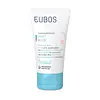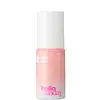What's inside
What's inside
 Key Ingredients
Key Ingredients

 Benefits
Benefits

 Concerns
Concerns

 Ingredients Side-by-side
Ingredients Side-by-side

Water
Skin ConditioningOenothera Biennis Oil
EmollientGlycerin
HumectantPentylene Glycol
Skin ConditioningPrunus Amygdalus Dulcis Oil
Skin ConditioningSimmondsia Chinensis Seed Oil
EmollientPentaerythrityl Distearate
EmulsifyingGlyceryl Stearate
EmollientButyrospermum Parkii Butter
Skin ConditioningPotassium Cetyl Phosphate
EmulsifyingOctyldodecanol
EmollientBetaine
HumectantHydrogenated Palm Glycerides
EmollientTocopheryl Acetate
AntioxidantPanthenol
Skin ConditioningEchium Plantagineum Seed Oil
Skin ConditioningCardiospermum Halicacabum Flower/Leaf/Vine Extract
Skin ConditioningHelianthus Annuus Seed Oil Unsaponifiables
EmollientXanthan Gum
EmulsifyingAcrylates/C10-30 Alkyl Acrylate Crosspolymer
Emulsion StabilisingCaprylyl Glycol
EmollientAllantoin
Skin ConditioningBisabolol
MaskingSodium Hydroxide
BufferingTocopherol
AntioxidantAscorbyl Palmitate
AntioxidantWater, Oenothera Biennis Oil, Glycerin, Pentylene Glycol, Prunus Amygdalus Dulcis Oil, Simmondsia Chinensis Seed Oil, Pentaerythrityl Distearate, Glyceryl Stearate, Butyrospermum Parkii Butter, Potassium Cetyl Phosphate, Octyldodecanol, Betaine, Hydrogenated Palm Glycerides, Tocopheryl Acetate, Panthenol, Echium Plantagineum Seed Oil, Cardiospermum Halicacabum Flower/Leaf/Vine Extract, Helianthus Annuus Seed Oil Unsaponifiables, Xanthan Gum, Acrylates/C10-30 Alkyl Acrylate Crosspolymer, Caprylyl Glycol, Allantoin, Bisabolol, Sodium Hydroxide, Tocopherol, Ascorbyl Palmitate
Water
Skin ConditioningOctocrylene
UV AbsorberDibutyl Adipate
EmollientButyl Methoxydibenzoylmethane
UV AbsorberEthylhexyl Salicylate
UV AbsorberButyloctyl Salicylate
Skin ConditioningDiethylamino Hydroxybenzoyl Hexyl Benzoate
UV FilterGlycerin
HumectantPhenylbenzimidazole Sulfonic Acid
UV AbsorberPropylheptyl Caprylate
EmollientEthylhexyl Triazone
UV AbsorberCetearyl Alcohol
EmollientBis-Ethylhexyloxyphenol Methoxyphenyl Triazine
Skin ConditioningDisodium Cetearyl Sulfosuccinate
CleansingBenzotriazolyl Dodecyl P-Cresol
UV AbsorberGlyceryl Stearate
EmollientMethylene Bis-Benzotriazolyl Tetramethylbutylphenol
UV FilterAluminum Starch Octenylsuccinate
AbsorbentJojoba Esters
EmollientSodium Hydroxide
BufferingHydroxyacetophenone
AntioxidantPentaerythrityl Distearate
EmulsifyingPanthenol
Skin ConditioningHelianthus Annuus Seed Extract
Skin ConditioningAllantoin
Skin ConditioningXanthan Gum
Emulsifying1,2-Hexanediol
Skin ConditioningCaprylyl Glycol
EmollientTocopheryl Acetate
AntioxidantTocopherol
AntioxidantCarnosine
Skin ConditioningDisodium EDTA
Gluconolactone
Skin ConditioningDecyl Glucoside
CleansingSodium Ascorbyl Phosphate
AntioxidantSodium Hyaluronate
HumectantBoron Nitride
AbsorbentAcacia Decurrens Extract
AstringentPolyglycerin-3
HumectantPropylene Glycol
HumectantPantolactone
HumectantWater, Octocrylene, Dibutyl Adipate, Butyl Methoxydibenzoylmethane, Ethylhexyl Salicylate, Butyloctyl Salicylate, Diethylamino Hydroxybenzoyl Hexyl Benzoate, Glycerin, Phenylbenzimidazole Sulfonic Acid, Propylheptyl Caprylate, Ethylhexyl Triazone, Cetearyl Alcohol, Bis-Ethylhexyloxyphenol Methoxyphenyl Triazine, Disodium Cetearyl Sulfosuccinate, Benzotriazolyl Dodecyl P-Cresol, Glyceryl Stearate, Methylene Bis-Benzotriazolyl Tetramethylbutylphenol, Aluminum Starch Octenylsuccinate, Jojoba Esters, Sodium Hydroxide, Hydroxyacetophenone, Pentaerythrityl Distearate, Panthenol, Helianthus Annuus Seed Extract, Allantoin, Xanthan Gum, 1,2-Hexanediol, Caprylyl Glycol, Tocopheryl Acetate, Tocopherol, Carnosine, Disodium EDTA, Gluconolactone, Decyl Glucoside, Sodium Ascorbyl Phosphate, Sodium Hyaluronate, Boron Nitride, Acacia Decurrens Extract, Polyglycerin-3, Propylene Glycol, Pantolactone
Ingredients Explained
These ingredients are found in both products.
Ingredients higher up in an ingredient list are typically present in a larger amount.
Allantoin is a soothing ingredient known for its protective and moisturizingg properties. Because of this, it is often added to products with strong active ingredients.
Studies show higher concentrations of this ingredient can promote wound healing.
Though it can be derived from the comfrey plant, allantoin is produced synthetically for cosmetic products to ensure purity.
Learn more about AllantoinCaprylyl Glycol is a humectant and emollient, meaning it attracts and preserves moisture.
It is a common ingredient in many products, especially those designed to hydrate skin. The primary benefits are retaining moisture, skin softening, and promoting a healthy skin barrier.
Though Caprylyl Glycol is an alcohol derived from fatty acids, it is not the kind that can dry out skin.
This ingredient is also used as a preservative to extend the life of products. It has slight antimicrobial properties.
Learn more about Caprylyl GlycolGlycerin is already naturally found in your skin. It helps moisturize and protect your skin.
A study from 2016 found glycerin to be more effective as a humectant than AHAs and hyaluronic acid.
As a humectant, it helps the skin stay hydrated by pulling moisture to your skin. The low molecular weight of glycerin allows it to pull moisture into the deeper layers of your skin.
Hydrated skin improves your skin barrier; Your skin barrier helps protect against irritants and bacteria.
Glycerin has also been found to have antimicrobial and antiviral properties. Due to these properties, glycerin is often used in wound and burn treatments.
In cosmetics, glycerin is usually derived from plants such as soybean or palm. However, it can also be sourced from animals, such as tallow or animal fat.
This ingredient is organic, colorless, odorless, and non-toxic.
Glycerin is the name for this ingredient in American English. British English uses Glycerol/Glycerine.
Learn more about GlycerinGlyceryl Stearate is a mix of glycerin and stearic acid.
It is used to stabilize the mixing of water and oil ingredients. By preventing these ingredients from separating, it can help elongate shelf life. It can also help thicken the product's texture.
As an emollient, it helps soften skin and supports barrier-replenishing ingredients.
In cosmetics, Glyceryl Stearate is often made from vegetable oils or synthetically produced.
This ingredient may not be fungal-acne safe
Fun fact: The human body also creates Glyceryl Stearate naturally.
Learn more about Glyceryl StearatePanthenol is a common ingredient that helps hydrate and soothe the skin. It is found naturally in our skin and hair.
There are two forms of panthenol: D and L.
D-panthenol is also known as dexpanthenol. Most cosmetics use dexpanthenol or a mixture of D and L-panthenol.
Panthenol is famous due to its ability to go deeper into the skin's layers. Using this ingredient has numerous pros (and no cons):
Like hyaluronic acid, panthenol is a humectant. Humectants are able to bind and hold large amounts of water to keep skin hydrated.
This ingredient works well for wound healing. It works by increasing tissue in the wound and helps close open wounds.
Once oxidized, panthenol converts to pantothenic acid. Panthothenic acid is found in all living cells.
This ingredient is also referred to as pro-vitamin B5.
Learn more about PanthenolPentaerythrityl Distearate isn't fungal acne safe.
Sodium Hydroxide is also known as lye or caustic soda. It is used to adjust the pH of products; many ingredients require a specific pH to be effective.
In small amounts, sodium hydroxide is considered safe to use. However, large amounts may cause chemical burns due to its high alkaline.
Your skin has a natural pH and acid mantle. This acid mantle helps prevent harmful bacteria from breaking through. The acid mantle also helps keep your skin hydrated.
"Alkaline" refers to a high pH level. A low pH level would be considered acidic.
Learn more about Sodium HydroxideTocopherol (also known as Vitamin E) is a common antioxidant used to help protect the skin from free-radicals and strengthen the skin barrier. It's also fat soluble - this means our skin is great at absorbing it.
Vitamin E also helps keep your natural skin lipids healthy. Your lipid skin barrier naturally consists of lipids, ceramides, and fatty acids. Vitamin E offers extra protection for your skin’s lipid barrier, keeping your skin healthy and nourished.
Another benefit is a bit of UV protection. Vitamin E helps reduce the damage caused by UVB rays. (It should not replace your sunscreen). Combining it with Vitamin C can decrease sunburned cells and hyperpigmentation after UV exposure.
You might have noticed Vitamin E + C often paired together. This is because it is great at stabilizing Vitamin C. Using the two together helps increase the effectiveness of both ingredients.
There are often claims that Vitamin E can reduce/prevent scarring, but these claims haven't been confirmed by scientific research.
Learn more about TocopherolTocopheryl Acetate is AKA Vitamin E. It is an antioxidant and protects your skin from free radicals. Free radicals damage the skin by breaking down collagen.
One study found using Tocopheryl Acetate with Vitamin C decreased the number of sunburned cells.
Tocopheryl Acetate is commonly found in both skincare and dietary supplements.
Learn more about Tocopheryl AcetateWater. It's the most common cosmetic ingredient of all. You'll usually see it at the top of ingredient lists, meaning that it makes up the largest part of the product.
So why is it so popular? Water most often acts as a solvent - this means that it helps dissolve other ingredients into the formulation.
You'll also recognize water as that liquid we all need to stay alive. If you see this, drink a glass of water. Stay hydrated!
Learn more about WaterXanthan gum is used as a stabilizer and thickener within cosmetic products. It helps give products a sticky, thick feeling - preventing them from being too runny.
On the technical side of things, xanthan gum is a polysaccharide - a combination consisting of multiple sugar molecules bonded together.
Xanthan gum is a pretty common and great ingredient. It is a natural, non-toxic, non-irritating ingredient that is also commonly used in food products.
Learn more about Xanthan Gum